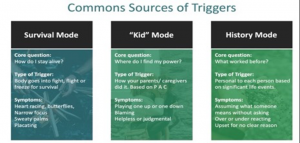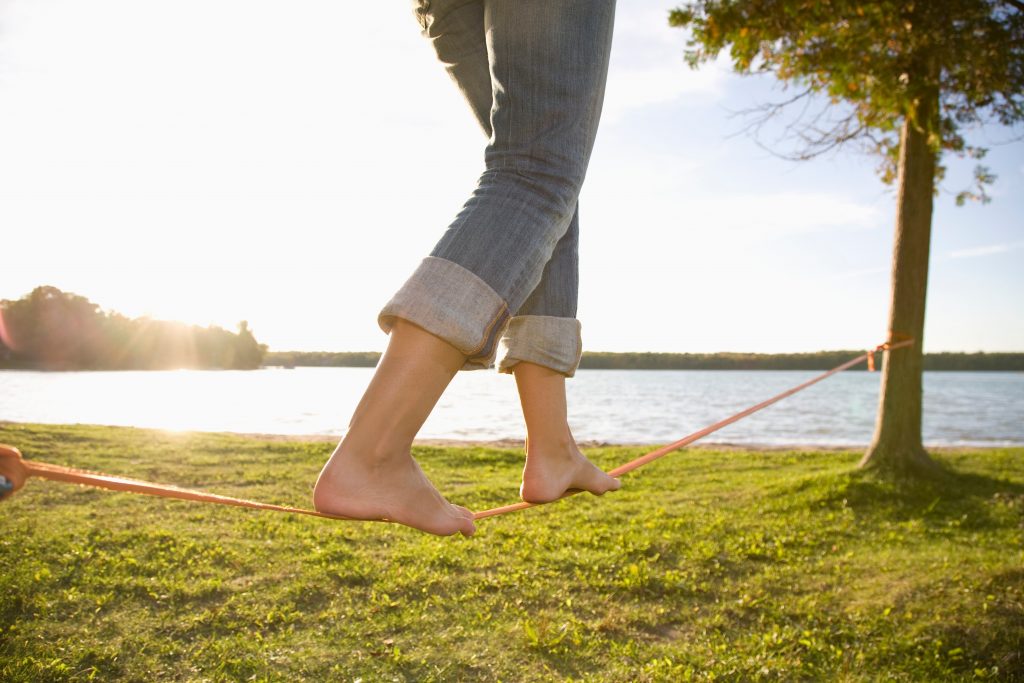Originally Published: June 30, 2022
Note: Today I’m sharing an excerpt from Chapter 2 of my new book, Dancing the Tightrope, What Falling Off a Horse Taught Me About Embracing Pressure, Fear and Uncertainty. In the following excerpt, we pick up the story soon after I fell off the horse. In this segment, I’m beginning to understand the accident through the lens of my own mindset.
As my recovery progressed, conversations started taking on a new tenor. Old patterns and Rules began rising to the surface, showing me their forms, their benefits—and their limitations.
While the bruises were fading and my bones healed, there was a consistent question explored in most of my conversations, both with friends who loved horses and friends who feared horses. “What happened?” It was a loaded question, defined by many facets. “What did you do wrong?” “Where did you make a mistake?” “Will you ever ride again?” “What would cause this to happen again?” “How do you make sure a horse never runs away with you again?”
And the question I asked myself: “If I don’t get back on, does it mean I am a failure?”
These questions were deep and starting to penetrate my very identity. I didn’t like it.
My various friends who had horses and knew very well the ins and outs, as well as dangers of trail riding, provided much needed perspective.
“There is a skill to balancing yourself on a horse moving downhill. The rider has a responsibility to coordinate with the horse so that he can carry you more easily.”
“Got to keep those heels down. It keeps you locked in the saddle.”
“When a horse starts running out of control, you bring them around into a circle. It’s like an emergency stop.”
My knowledge-hungry brain ate up the advice, starving for a technique that I could deploy should I ever choose to ride again.
Yet one conversation pointed to something deeper, something in the fog that occasionally showed itself in ever-morphing shapes and disappeared as soon as I looked at it.
“You seemed so confident. It never occurred to me that you were anything but totally proficient.” So said Babs as we discussed what had happened that day. We had only ridden together twice.
Confidence. It’s something I had cultivated since my first day in the corporate world—and probably even before that. I built my adult form of confidence on the foundation of so many of my childhood Rules.
“Don’t get caught” developed into “I’ve got this.” (Translation: Even though I’m faking it, I’m good at faking, so who will ever know?)
“Damned if you do, damned if you don’t” developed into “I will beat myself up, so you don’t have to” (Translation: I don’t have to change anything because I’ve eaten the slimy vegetables and paid my penance.)
“Quitting is the way out” developed into “Look at this other thing I’m good it” (Translation: If it doesn’t come easy, I don’t want to have to take the time to develop mastery)
This Swiss cheese confidence was destined to collapse under pressure. All the skills and knowledge in the world would not break those patterns.
In my coaching work with leaders for the several years prior, I had begun breaking lifelong patterns like these into three ‘buckets,’ with different origins and different ways out:
- Survival Mode
- Kid Mode
- History Mode

In some ways, all three modes played out in my experience falling off the horse. When Mocha started down the pivotal hill, his big gait felt like a trot to me. The sensation of speed immediately sent a shot of adrenaline into my system. Survival Mode was triggered in milliseconds. Now I was in Fight, Flight, or Freeze. At this point, because of my lack of skills and more importantly, my low pressure threshold, I had no choice but to try to hang on when pulling back on the reins didn’t work.
We all have Survival Mode, and the chemistry of it operates in essentially the same way in all of us. It’s non-negotiable hardwiring granted to us at birth.
Earlier in my ride, Kid Mode had been triggered. Kid Mode is anytime we feel a power differential and we do things to get our power back. This idea started coming to me when working with Eric Berne’s Transactional Analysis in a leadership program I was teaching. While I did almost no deep study on the method, what I saw was easily applicable to the corporate world.
In my Kid Mode view of the world, I pictured a tightrope, where on the tightrope itself, we walked in a Power With approach to solving problems and leading changes. With such a narrow, wobbly path to walk, we were bound to fall off on one side or the other. On one side was the Child side, where we fell into a ‘Power Under’ approach. Every time I walked into my boss’s office and said something to the effect of “I’ve tried everything, nothing works, it’s everybody’s fault but mine.” I was in the ‘child ditch.’ It’s tailor made for victims.
When it dawned on me that Mocha was the one in power after walking me through the spider web (albeit unintentionally), I tried making him like me—a classic Power Under strategy to even out the power differential.
On the other side is the Parent side, where we fall into a Power Over approach. Of course, more than once, I had walked into my boss’s office trying to get away with the “You need to fix this” attitude. Getting all grabby with the reins and trying to be forceful instead of communicating were my feeble attempts to gain power over Mocha on the way down the hill.
Can you see how these methods cause us to over and under react, always swinging off the tightrope?
In many ways, Kid Mode is shared by all of us, much like Survival Mode. If we were raised in any setting where there was a power differential, we have strategies for dealing with situations of Power Under, Power Over.
As I worked with clients—and myself—in understanding the different mindsets (Berne called them ‘ego states’), I needed a way to organize it. You can look at the ‘centered mindset’ as on the tightrope. I can fall off the tightrope by over or under reacting to the situation, much like I did with Mocha. In that case, I bounced back and forth, from trying to get him to like me to trying to have power over him and then going back to feeling helpless. Really helpless.
Right after my accident, I started working with a leadership team whose core role in the organization was like herding cats. There were a lot of power dynamics in play. They were executives in their role, but not always in their actions. The team lamented their frustration as we worked through the give and take of their various decisions.
In many ways, we began to recognize that what they were seeking was the ability to be present when in difficult conversations, while delivering unwelcome news and in making strategic decisions. They wanted executive presence. I created a tool for them to see where they were at any given time in their interactions. (If you are interested in seeing this tool, hit reply to this email. I’ll send you the PDF.) How we bounce around the strategies we choose is deeply colored by our life experiences.
Our life experiences also create our History Mode—and each of us has a completely different set of life defining moments that shape who we are and how we make sense of the world. While we may share patterns of ‘trauma,’ our reactions to what happens in our lives, both good and bad, are unique to each of us.
Our ways of dealing with pressure start forming from the time we are born. We learn from watching our parents and other family members, teachers, peers, and other authority figures. We learn from our experiences and how we handle what happens to us. As we are growing up, we are like little scientists, studying the world and deciding who we are and how we fit in it. This becomes our ‘conditioning.’
We document those discoveries in our bodies and our ways of being in the world. That conditioning becomes our patterns for dealing with the pressures of life. Feeling betrayed? You’ve got a pattern for that. Not getting what you want? You’ve got a pattern for that.
My own History Mode patterns played a role from the moment I accepted the invitation to ride, straight through to the accident, the recovery, and beyond. There’s no getting around it.
Some of our patterns are super useful. That instinct to hit the brakes when something rolls in front of our car? Useful. That instinct to hit someone that just took something we wanted away? Not so great, especially in corporate life.
My pattern around showing confidence—my pattern of "I've got this"—was very useful in corporate life, where there is always more work to do than can possibly be done. The insatiable work monster was kept fed and mostly quiet by people like me.
Our early years as little scientists established a huge repertoire of patterns that operate like automatic programs. They run in the background without any conscious thought or help from us—and they take energy, much like an app running in the background on a smartphone.
You can think of our patterns like the buttons we push to start an app on the phone. Rather than having to open the screen and find the icon, our buttons get pushed by the pressure of the situation. Here are examples of the types of things that happen that will push your buttons and cause us to operate from conditioning (instead of from the actual situation in front of us):
- Not getting what you want
- Feeling betrayed
- Making a mistake
- Watching someone else be praised for something you did
- Getting embarrassed
- Feeling treated unfairly
- Getting “screwed” by a situation
- Wanting to please others
- Looking for approval
- Wanting to be right
- Fearing failure
- Feeling responsible for the fate of others
- Being told your work is not good
Our unconscious patterns run us, just as surely as if we were robots running on the programming code of their inventor. Learning to operate creatively and consciously requires MUCH MORE than a simple decision to change. Why? Because emotions lock the original programming into place. Until we access those emotions and then ‘rewrite’ the program, we cannot change the pattern.
While my body was running down the hill on Mocha, the robot was running my mind. If I were ever to ride again, it seemed wise to do something about the robot. In other words, it was not a skill problem. It was a mindset problem.
[End of excerpt]
At this stage of my recovery, I truly was not sure what had caused my accident – and I was very afraid of a repeat. The rest of the book outlines my discoveries of just what a big role my mindset plays in how I handle pressure, fear and uncertainty. While it’s a story of getting back on the horse, I believe the mindset lessons I learned apply to any domain where pressure, fear and uncertainty are present.
Know someone who would love this article? Share it with them.

